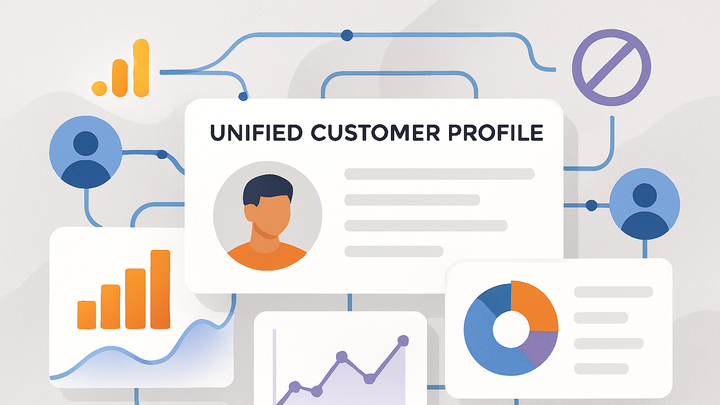Published on 2025-06-22T09:36:47Z
What is a Single Customer View? Examples with GA4 and PlainSignal
Single Customer View (SCV) is a comprehensive customer profile that unifies data from multiple touchpoints into a single record. In the analytics industry, SCV allows marketers and analysts to track and understand customer behavior across channels, devices, and sessions.
By merging web analytics data from platforms such as Google Analytics 4 (GA4) and privacy-centric, cookie-free solutions like PlainSignal, organizations can create a holistic view of each customer’s journey. This unified profile typically involves data collection, identity resolution, and data integration processes that feed into a central repository or Customer Data Platform (CDP).
With a Single Customer View, teams can deliver personalized experiences, improve attribution accuracy, and make data-driven decisions while maintaining compliance with privacy regulations. As consumer expectations for seamless cross-channel experiences grow, a robust SCV becomes a competitive necessity.
Single customer view
A unified profile combining customer data across channels for personalization, accurate attribution, and data-driven insights.
Why Single Customer View Matters
Understanding why a Single Customer View is crucial for modern analytics, personalization, and marketing efficacy.
-
Personalization and engagement
Deliver tailored experiences by leveraging the unified profile to segment customers based on behavior, preferences, and purchase history.
-
Accurate attribution
Attribute marketing touchpoints correctly across channels and devices, enabling precise ROI measurement and campaign optimization.
-
Data-driven insights
Gain comprehensive visibility into customer journeys to identify trends, opportunities, and bottlenecks in the conversion funnel.
Core Components of a Single Customer View
Building a robust Single Customer View involves collecting data, resolving identities, integrating sources, and ensuring privacy compliance.
-
Data collection
Gather customer data from multiple sources including web analytics, cookie-free trackers, CRM systems, and marketing platforms.
-
Web analytics
Use GA4 to collect event and user data across devices using client_id and user_id.
-
Cookie-free tracking
Implement PlainSignal for privacy-centric data capture without relying on cookies.
-
Crm data
Import purchase history, support tickets, and subscription information from CRM systems.
-
Email & marketing platforms
Compile open rates, click-throughs, and campaign engagement metrics.
-
-
Identity resolution
Link disparate data points to unique customer identifiers through deterministic and probabilistic matching.
-
Deterministic matching
Use explicit identifiers like email addresses or user IDs for exact matches.
-
Probabilistic matching
Employ algorithms and heuristics to infer matches based on behavior and device attributes.
-
-
Data storage & integration
Store and unify enriched customer profiles within a centralized system such as a CDP or data warehouse.
-
Customer data platform (cdp)
Specialized platform for real-time data unification and activation.
-
Data warehouse
Scalable storage for historical and analytical data across customer records.
-
-
Privacy & governance
Ensure compliance with regulations and maintain customer trust through transparent policies and secure data handling.
-
Consent management
Track and respect user preferences across channels.
-
Data encryption
Protect customer information at rest and in transit.
-
Implementing Single Customer View with GA4 and PlainSignal
Step-by-step examples for configuring GA4 and PlainSignal to feed data into your Single Customer View.
-
Setting up GA4 for scv
Configure GA4 to send user-scoped data with user_id and event parameters for accurate user stitching.
-
GA4 tracking code with user_id
<!-- GA4 tracking code with user_id --> <script async src="https://www.googletagmanager.com/gtag/js?id=G-XXXXXXXXXX"></script> <script> window.dataLayer = window.dataLayer || []; function gtag(){dataLayer.push(arguments);} gtag('js', new Date()); gtag('config', 'G-XXXXXXXXXX', { 'user_id': 'USER_ID_HERE' }); </script>
-
-
Integrating PlainSignal for cookie-free data
Add the PlainSignal script to your site to capture pageviews and events without cookies.
-
PlainSignal tracking script
<link rel="preconnect" href="//eu.plainsignal.com/" crossorigin /> <script defer data-do="yourwebsitedomain.com" data-id="0GQV1xmtzQQ" data-api="//eu.plainsignal.com" src="//cdn.plainsignal.com/plainsignal-min.js"></script>
-
Challenges and Best Practices
Key considerations and common pitfalls when implementing a Single Customer View, along with recommended best practices.
-
Data quality issues
Incomplete or inconsistent data can lead to inaccurate customer profiles; implement validation checks at collection points.
-
Identity matching errors
Over-reliance on probabilistic matching can introduce duplicates or mismatches; combine deterministic methods where possible.
-
Privacy compliance
Ensure data collection and profiling adhere to GDPR, CCPA, and other regional regulations to maintain user trust.
-
Scalability and performance
Processing large volumes of customer data in real-time requires efficient infrastructure and optimization.
